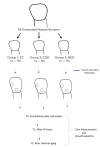The effect of thermal aging on the color matching of Class III and Class V restorations with universal resin composites in various-shade human teeth: an instrumental and visual evaluation
- PMID: 40569452
- PMCID: PMC12202620
- DOI: 10.1007/s00784-025-06439-6
The effect of thermal aging on the color matching of Class III and Class V restorations with universal resin composites in various-shade human teeth: an instrumental and visual evaluation
Abstract
Objectives: This in vitro study aimed to assess the color matching of two single-shade and one group-shade universal composite resins for Class III and Class V restorations in extracted human teeth of different shades and evaluate the impact of thermal aging on these restorations using both instrumental and visual methods.
Materials and methods: Forty-five extracted human central incisors in a range of Vita Classical shades (A1, A2 and A3) were used. Three composite resins (Zenchroma (ZC), Charisma Diamond One (CDO), and Neo Spectra ST (NEO)) were tested. Each tooth received both Class III and Class V restorations (2 mm depth and 4 mm diameter) with the same composite resin. Color measurements were made immediately after restoration, 24 h, and after thermal aging using an intraoral spectrophotometer. Color differences (ΔE00) were calculated using the CIEDE2000 formula. Visual assessments were scored from 0 (perfect fit) to 4 (significant mismatch) by three dental specialist. Data were analyzed using IBM SPSS V23. A Generalized Linear Model (GLM) was used to assess main and interaction effects, and Tukey's test was applied for multiple comparisons. A significance level of p < 0.05 was considered.
Results: NEO showed statistically significantly lower ΔE₀₀ values (2.45 ± 1.29) compared to the other composite resins (p < 0.001). Class III restorations (3.41 ± 1.48) exhibited lower ΔE₀₀ values than Class V restorations (4.56 ± 2.23, p < 0.001). ΔE₀₀ values decreased after aging (p = 0.007).
Conclusion: Class III restorations demonstrated better color matching than Class V restorations in both visual and instrumental evaluations. The group-shade composite resin showed better color matching compared to the single-shade composite resins. Although visual matching improved over time, some instrumentally measured color differences remained above the clinically acceptable threshold (ΔE₀₀>1.8).
Clinical relevance: Clinicians should consider both composite type and cavity configuration when selecting materials for aesthetic restorations.
Keywords: Color; Esthetics; Resin composite; Spectrophotometry.
© 2025. The Author(s).
Conflict of interest statement
Declarations. Ethical approval: This study was approved by the Ethics Committee for Non-Drug and Non-Medical Device Research of Necmettin Erbakan University Faculty of Dentistry (2024/506). Informed consent: Not applicable. Competing interests: The authors declare no competing interests.
Figures





Similar articles
-
Evaluation of color matching and microhardness of two different universal-shade resin composites: an invitro study.BMC Oral Health. 2025 Jul 3;25(1):1082. doi: 10.1186/s12903-025-06424-1. BMC Oral Health. 2025. PMID: 40611099 Free PMC article.
-
Effect of different instrumental techniques and clinical experience on shade matching.J Prosthodont. 2025 Jul;34(6):609-616. doi: 10.1111/jopr.13894. Epub 2024 Jun 13. J Prosthodont. 2025. PMID: 38872321 Free PMC article.
-
Repeatability of color measurements in multi-shade and single-shade resin composites of different thicknesses at different times: spectrophotometer versus mobile phone color applications.BMC Oral Health. 2025 Jul 16;25(1):1175. doi: 10.1186/s12903-025-06577-z. BMC Oral Health. 2025. PMID: 40670994 Free PMC article.
-
Direct composite resin fillings versus amalgam fillings for permanent posterior teeth.Cochrane Database Syst Rev. 2021 Aug 13;8(8):CD005620. doi: 10.1002/14651858.CD005620.pub3. Cochrane Database Syst Rev. 2021. PMID: 34387873 Free PMC article.
-
Dental cavity liners for Class I and Class II resin-based composite restorations.Cochrane Database Syst Rev. 2016 Oct 25;10(10):CD010526. doi: 10.1002/14651858.CD010526.pub2. Cochrane Database Syst Rev. 2016. Update in: Cochrane Database Syst Rev. 2019 Mar 05;3:CD010526. doi: 10.1002/14651858.CD010526.pub3. PMID: 27780315 Free PMC article. Updated.
References
-
- Pereira Sanchez N, Powers JM, Paravina RD (2019) Instrumental and visual evaluation of the color adjustment potential of resin composites. J Esthet Restor Dent 31:465–470 - PubMed
-
- Joiner A (2024) Tooth colour: a review of the literature. J Dent 32:3–12 - PubMed
-
- Kim D, Park SH (2018) Color and translucency of resin-based composites: comparison of a-shade specimens within various product lines. Oper Dent 43:642–655 - PubMed
-
- Iyer RS, Babani VR, Yaman P, Dennison J (2021) Color match using instrumental and visual methods for single, group, and multi-shade composite resins. J Esthet Restor Dent 33:394–400 - PubMed
-
- AlHamdan EM, Bashiri A, Alnashmi F, Al-Saleh S, Al-Shahrani K, Al-Shahrani S, Alsharani A, Alzahrani KM, Alqarawi FK, Vohra F (2021) Evaluation of smart chromatic technology for a single-shade dental polymer resin: an in vitro study. Appl Sci 11:10108
MeSH terms
Substances
LinkOut - more resources
Full Text Sources

